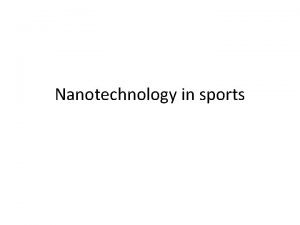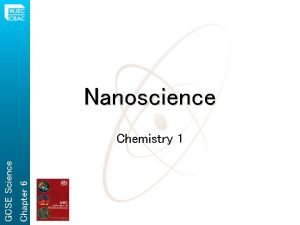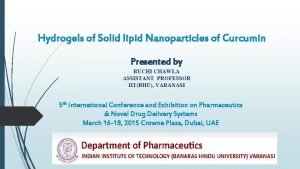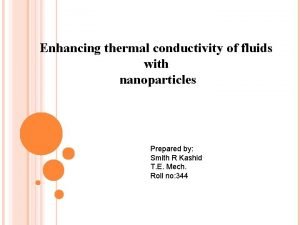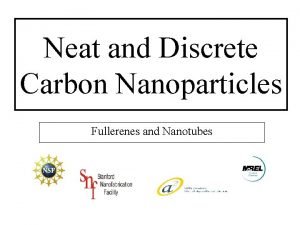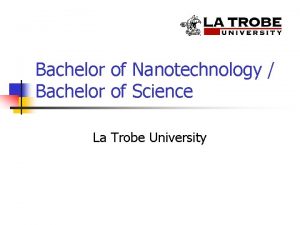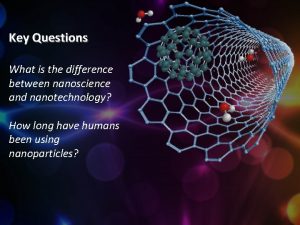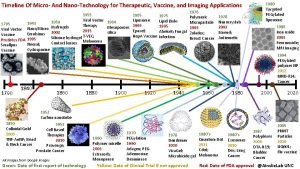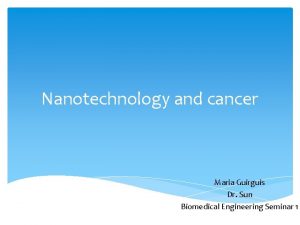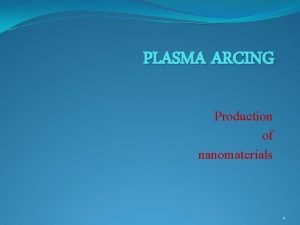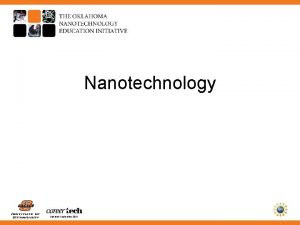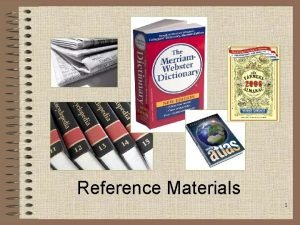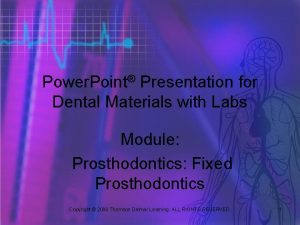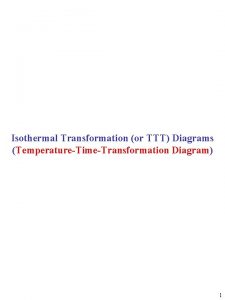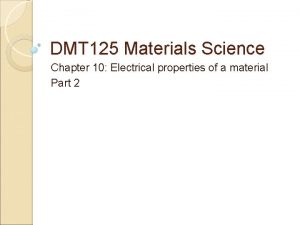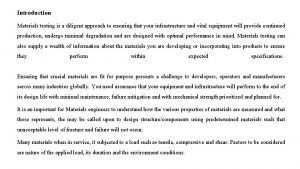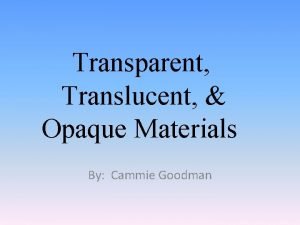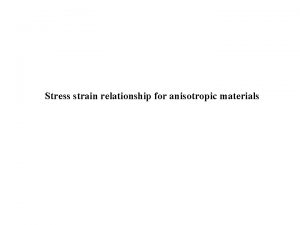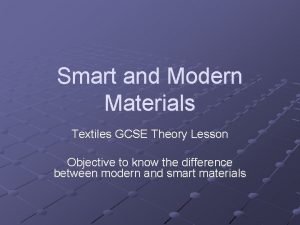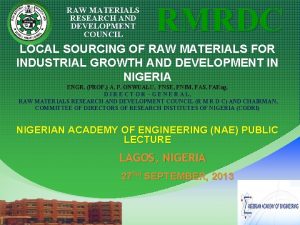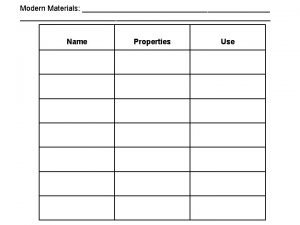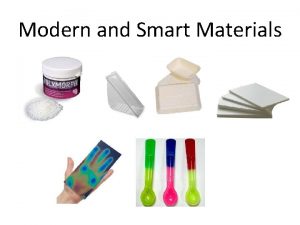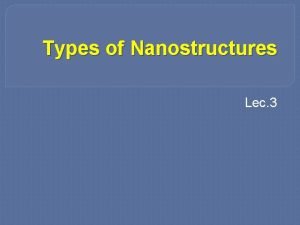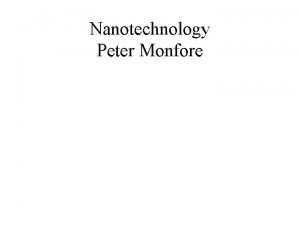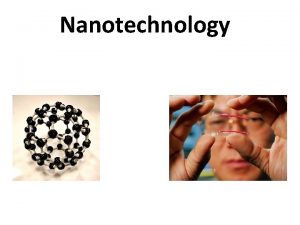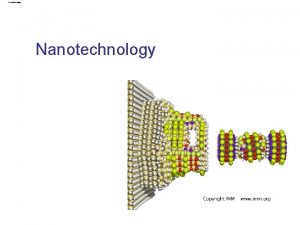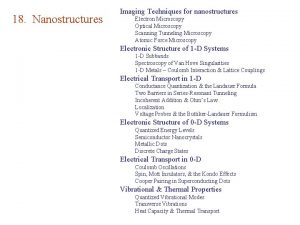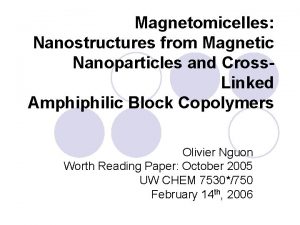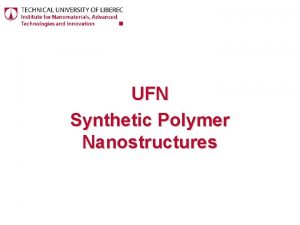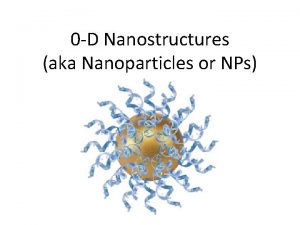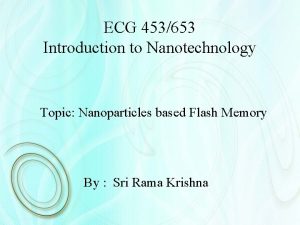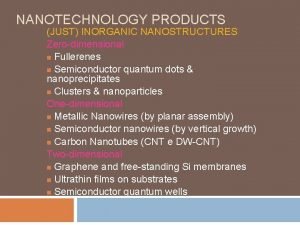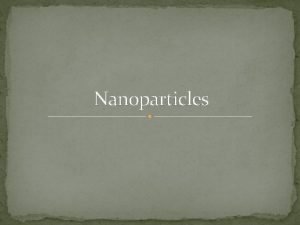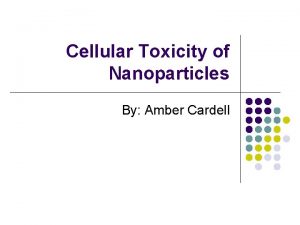Materials in Nanotechnology Introduction to Nanoparticles and Nanostructures






















































- Slides: 54

Materials in Nanotechnology Introduction to Nanoparticles and Nanostructures Terence Kuzma

Outline • Definition and Examples (Lecture 1) • Physical Properties - Size Crystal Structure Melting Point Mechanical Strength • Optical Properties (Lecture 2) • Surface Plasmons • Quantum Confinement Effects • Electrical Properties • Health Concerns

Definition of Nanoparticle • A structure with at least 1 dimension less than 1 µm. • Examples: – Sphere-like particles • Ag nanoparticles, buckyballs – Rod-like particles • Si & Ni nanowires – Tube-like particles • Carbon nanotubes • Ti. O 2 nanotubes

Size Changes Material Properties The gold we know: The gold we are discovering: Material properties don’t change with size - resistivity - melting point - optical absorption Material properties (such as optical Absorption, shown here) change with the size of the gold nanoparticle.

Outline • Definition and Examples • Physical Properties - Size Crystal Structure Melting Point Mechanical Strength • Optical Properties • Electrical Properties • Health Concerns

Unique Characteristics of Nanoparticles • Large surface to volume ratio • High percentage of atoms/molecules on the surface • Surface forces are very important, while bulk forces are not as important. • Metal nanoparticles have unique light scattering properties and exhibit plasmon resonance. • Semiconductor nanoparticles may exhibit confined energy states in their electronic band structure (e. g. , quantum dots) • Can have unique chemical and physical properties • Same size scale as many biological structures

Examples of Unusual Properties • • Lowered phase transition temps Increased mechanical strength Different optical properties Altered electrical conductivity Magnetic properties Unique biological response Unique chemical reactivity

Physical Properties of Nanoparticles • Physical properties of nanoparticles are dependent on: – Size – Shape (spheres, rods, platelets, etc. ) – Composition – Crystal Structure (FCC, BCC, etc. ) – Surface ligands or capping agents – The medium in which they are dispersed

Size # of atoms • Molecules, nanoparticles, and bulk materials can be distinguished by the number of atoms comprising each type of material. • Note: these are very approximate numbers! 1 Molecules 10 102 103 Nanoparticles 104 105 106 Bulk Poole, C. , Owens, F. Introduction to Nanotechnology. Wiley, New Jersey. 2003

Size • Nanoparticles exhibit unique properties due to their high surface area to volume ratio. • A spherical particle has a diameter (D) of 100 nm. – Calculate the volume (V) and surface area (SA) Poole, C. , Owens, F. Introduction to Nanotechnology. Wiley, New Jersey. 2003

Surface Area: Volume Ratio • This gives an approximate surface area to volume ratio of >107: 1 which is significantly larger than a macro sized particle. • As the surface area to volume ratio increases so does the percentage of atoms at the surface and surface forces become more dominant. • Generally accepted material properties are derived from the bulk, where the percentage of atoms at the surface is miniscule. These properties change at the nanoscale.

Size Some example calculations for volume and surface area of nanoparticles. These calculations use nm as unit of length. Nanoparticle Diameter (nm) Diameter (um) 1 0. 001 10 0. 01 100 0. 1 10000 10 1000000 1000 Volume Surface Area SA: Vol Ratio (nm 3) (nm 2/nm 3) 0. 524 3. 14 6 524 314 0. 6 523598 31416 0. 06 5. 24 E+08 3. 14 E+06 0. 006 5. 24 E+11 3. 14 E+08 0. 0006 5. 24 E+14 3. 14 E+10 0. 00006 5. 24 E+17 3. 14 E+12 0. 000006

Surface Area: Volume Ratio In this graph: SA = nm 2 Vol = nm 3 SA: Vol Ratio = nm 2/nm 3 The ratio increases dramatically when the nanoparticle diameter drops below about 100 nm

Size • As the percentage of atoms at the surface increases, the mechanical, optical, electrical, chemical, and magnetic properties change. – For example optical properties (color) of gold and silver change, when the spatial dimensions are reduced and the concentration is changed.

Size Melting point as a function of particle size • Nanoparticles have a lower melting point than their bulk counterparts Melting point of gold nanoparticles as a function of size. Source: Ph. Buffat and J-P. Borel, Phys. Rev. A 13, 2287– 2298 (1976)

Crystal Structure • Most solids are crystalline with their atoms arranged in a regular manner. • This arrangement of atoms impacts the functionality of the material. • Some solids have this order presented over a long range as in a crystal. • Amorphous materials such as glass and wax lack long range order, but they can have a limited short range order, defined as the local environment that each atom experiences. Poole, C. , Owens, F. Introduction to Nanotechnology. Wiley, New Jersey. 2003

Crystal Structure • The spatial arrangement of atoms in a crystal lattice is described by its unit cell. • The unit cell is the smallest possible volume that displays the full symmetry of the crystal. • Many materials have a “preferred” unit cell.

Crystal Structure • In 3 dimensions, unit cells are defined by 3 lattice constants and 3 angles. • This leads to 14 Bravais lattices, each having characteristic restrictions on the lattice constants, angles, and centering of atoms in the unit cell. b c a

Crystal Structures For cubic unit cells, there are three centering types: Simple Cubic (SC) Body Centered Cubic (BCC) Face Centered Cubic (FCC)

Size & Crystal Structure • Most metals in the solid form close packed lattices • Ag, Al, Cu, Co, Pb, Pt, Rh are Face Centered Cubic (FCC) • Mg, Nd, Os, Re, Ru, Y, Zn are Hexagonal Close Packed (HCP) • Cr, Li, Sr can form Body Centered Cubic (BCC) as well as (FCC) and (HCP) depending upon formation energy

Size & Crystal Structure • How does crystal structure impact nanoparticles? • Nanoparticles have a “structural magic number”, that is, the optimum number of atoms that leads to a stable configuration while maintaining a specific structure. • Structural magic number = minimum volume and maximum density configuration • If the crystal structure is known, then the number of atoms per particle can be calculated. Poole, C. , Owens, F. Introduction to Nanotechnology. Wiley, New Jersey. 2003

Close-Packed Magic Number Clusters • • • Magic Number = Cluster has a complete, regular outer geometry Formed by successively packing layers around a single metal atom. Number of atoms (y) in shell (n): y = 10 n 2 + 2 (n = 1, 2, 3…) Maximum number of nearest neighbors (metal-metal hcp packing) Decreasing percentage of surface atoms as cluster grows J. D. Aiken III, R. G. Finke, J. Mol. Catal. 1999, 145, 1

Size & Crystal Structure • For n layers, the number of atoms N in an approximately spherical FCC nanoparticle is given by the following formula: N = 1/3[10 n 3 – 15 n 2 + 11 n - 3] • The number of atoms on the surface Nsurf NSurf = 10 n 2 – 20 n +12

Size & Crystal Structure Example Calculations: How many atoms (N) are in idealized Au NP’s with the following diameters? 5 nm Au NP: With 9 shells, n = 9 and NP diameter = 17 d = 4. 896 nm N = 1/3[10 n 3 – 15 n 2 + 11 n - 3] N = 2057 Other Approximate Values 10 nm = 17, 900 20 nm = 137, 000 30 nm = 482, 000 40 nm = 1. 1 million 50 nm = 2. 2 million Poole, C. , Owens, F. Introduction to Nanotechnology. Wiley, New Jersey. 2003

Wulff Crystal Shapes • Used to determine the shape of a crystal when formed under thermodynamic equilibrium conditions. • Surfaces = areas of high energy • Different facets have different surface energies. • Objective is to minimize the total surface energy of the xtal.

Wulff Crystal Shapes Intercepts (x = ∞, y = 1) Face (0 1) y These plots represent a simplified view of crystal faces in 2 -dimensions. Miller Indices in 2 -D: Notation is based on where the “plane” (or face) crosses the x- and y-axes. x {1 0} Family of Crystal Faces includes all of the following faces (1 0), (-1 0), (0 1), (0 -1) y Intercepts x = 1, y = 1 Face (1 1) x {1 1} Family of Crystal Faces includes all of the following faces (1 1), (-1 -1), (1 -1)

Wulff Crystal Shapes Wulff Plots: Length of arrow is proportional to surface energy of that face. Longer arrows denote higher energy surfaces. Increasing energy of {1 1} faces Energy of {1 0} remains constant. Crystal Shapes: Draw outline of inner-most facets to determine shape of the crystal. The result is that high energy faces expose less surface area to the external environment. low energy face high energy face

Deviations from Ideal Crystals • Often, nanoparticles (nanocrystals) do not form welldefined crystal facets. • The Wulff crystal shapes are idealized cases where the crystal surface energies determine the shape (thermodynamic control). • Kinetic factors often play a major role in crystal growth. This explains why different processing conditions can lead to different morphologies for the same material. • Roughening Temperature: Above this temperature, surface atoms on a growing crystal have increased mobility (liquid-like surface) and well-defined facets do not form. • At elevated temps, all faces tend to have similar energy (e. g. , on macroscale consider the C-Z process for Si).

Altered Lattice Constants • Compare lattice structure of nano and bulk materials • Shortening of bonds near the surface • Surface reconstruction Original Structure Shortened Surface Bonds Shifted Surface Bonds

Mechanical Strength • Calculated values for mechanical strength of idealized xtals = 100 to 1000 X than experimental • Differentiate between wires and nanocomposites • Transition to higher strength occurs at about 10 microns (above the nanoscale) • 2 possible reasons: – Lower number of defects inside the nanowire – Fewer surface defects

Materials in Nanotechnology Introduction to Nanoparticles and Nanostructures Part 2 Terence Kuzma

Outline • Definition and Examples • Physical Properties • Optical Properties • Surface Plasmons • Quantum Confinement • Electrical Properties • Health Concerns

Optical Properties • The size dependence on the optical properties of nanoparticles is the result of two distinct phenomena: – Surface plasmon resonance for metals – Increased energy level spacing due to the confinement of delocalized energy states. Most prominent in semiconductors Poole, C. , Owens, F. Introduction to Nanotechnology. Wiley, New Jersey. 2003

Optical Properties • Surface Plasmons – Recall that metals can be modeled as an arrangement of positive ions surrounded by a sea of free electrons. – The sea of electrons behaves like a fluid and will move under the influence of an electric field -- - --- -- - - + - + ------- -------------- -- --- + - + --------+ + - + + E-field

Optical Properties Surface Plasmons – If the electric field is oscillating (like a photon), then the sea of electrons will oscillate too. These oscillations are quantized and resonate at a specific frequency. Such oscillations are called plasmons. Resonance at a metal surface Resonance in metal NP Source: MRS Bulletin 2005, 30(5), 338.

Optical Properties • Surface Plasmons – Formal definition: Plasmons are the coherent excitation of free electrons in a metal. – The plasmon resonance frequency (f) depends on particle size, shape, and material type. It is related to the plasmon energy (E) by Planck’s constant. E=h*f – Surface plasmons are confined to the surface of the material. – The optical properties of metal nanoparticles are dominated by the interaction of surface plasmons with incident photons.

Optical Properties Surface Plasmons – Metal nanoparticles like gold and silver have plasmon frequencies in the visible range. – When white light impinges on metal nanoparticles the wavelength corresponding to the plasmon frequency is absorbed. – The spectral locations, strengths, and number of plasmon resonances for a given particle depend on the particle’s shape and size.

Optical Properties • Absorption spectra of spherical Au nanoparticles Optical absorption spectrum of 20 - and 80 -nm gold nanoparticles embedded in glass. [Adapted from F. Gonella et al. , in Handbook of Nanostructured Material and Nanotechnology, H. S. Nalwa, ed. , Academic Press, San Diego, 2000, Vol. 4, Chapter 2, p. 85. ]

Optical Properties Surface Plasmons: Shape dependence of absorption spectra • The amount of light that is scattered into the far field is described by the scattering cross section (SCS). The SCS is plotted against the wavelength of light used to illuminate a particle from a specific angle. • The arrows indicate the illumination angle, and their colors correspond to the different plot lines. Martin, Olivier J. F. “Spectral response of plasmon resonant nanoparticles with non-regular shape”. Optics Express Col. 6. No. 11 May 2000

Optical Properties Surface Plasmons: Shape dependence of absorption spectra • Triangular shaped nanoparticles produce plasmons with altered frequency and magnitude Martin, Olivier J. F. "Plasmons". Plasmons. 22 Mar. 2006. Ecole Polytechnique Fédérale de Lausanne. 26 Jan. 2003.

Optical Properties • Energy levels: from atoms to bulk materials… – The Pauli Exclusion Principle states that electrons can only exist in unique, discrete energy states. – In an atom the energy states couple together through spin-orbit interactions to form the energy levels commonly discussed in an introductory chemistry course. – When atoms are brought together in a bulk material, the energy states form nearly continuous bands of states, or in semiconductors and insulators, nearly continuous bands separated by an energy gap. Atoms: Discrete Energy Levels Energy N Bulk Materials: Band Structures Energy

Optical Properties • Energy levels – In semiconductors and insulators, the valance band corresponds to the ground states of the valance electrons. – In semiconductors and insulators, the conduction band corresponds to excited states where electrons are a free to move about in the material and participate in conduction. – In order for conduction to take place in a semiconductor, electrons must be excited out of the valance band, across the band gap into the conduction band. This process is called carrier generation. – Conduction takes place due to the empty states in the valence band (holes) and electrons in the conduction band. Ec band gap Ev Electron excited into conduction band

Optical Properties • Energy level spacing – In semiconductors and insulators a photon with an energy equal to the band gap energy is emitted when an electron in the conduction band recombines with a hole in the valance band. – The electronic band structure of a semiconductor dictates its optical properties. – Ga. P, a material commonly used for green LEDs, has an intrinsic band gap of 2. 26 e. V. Carrier recombination across the gap results in the emission of 550 nm light. Eg = 2. 26 e. V λ=550 nm

Optical Properties • Energy level spacing and quantum confinement – The reduction in the number of atoms in a material results in the confinement of normally delocalized energy states. – Electron-hole pairs become spatially confined when the dimensions of a nanoparticle approach the de Broglie wavelength of electrons in the conduction band. – As a result the spacing between energy bands of semiconductor or insulator is increased (Similar to the particle in a box scenario, of introductory quantum mechanics. ) Bulk Materials Nano Materials Energy Eg Increased band gap

Optical Properties • Energy level spacing and quantum confinement – Semiconductor nanoparticles that exhibit 3 dimensional confinement in their electronic band structure are called quantum dots. – What does this all mean? • Quantum dots are band gap tunable. • We can engineer their optical properties by controlling their size. • For this reason quantum dots are highly desirable for biological tagging.

Optical Properties • Energy level spacing and quantum confinement – As semiconductor particle size is reduced the band gap is increased. – Absorbance and luminescence spectra are blue shifted with decreasing particle size. Cd. Se quantum dots Jyoti K. Jaiswal and Sanford M. Simon. Potentials and pitfalls of fluorescent quantum dots for biological imaging. TRENDS in Cell Biology Vol. 14 No. 9 September 2004

Optical Properties Example: Absorption Spectra of Cd. Se quantum dots

Outline • • • Definition and Examples Physical Properties Optical Properties Electrical Properties Health Concerns

Electrical Properties • Effect of structure on conduction – If nanostructures have fewer defects, one would expect increased conductivity vs macroscale • Other electrical effects on the nanoscale: – Surface Scattering – Change in Electronic Structure – Ballistic Conduction – Discrete Charging – Tunneling Conduction – Microstructural Effects

Surface Scattering • Electrons have a mean-free-path (MFP) in solid state materials. • MFP is the distance between scattering events as charge carriers move through the material. • In metals, the MFP is on the order of 10’s of nanometers. • If the dimensions of a nanostructure are smaller than the electron MFP, then surface scattering becomes a factor.

Surface Scattering • There are two types of surface scattering: elastic and inelastic. • Elastic scattering does not affect conductivity, while inelastic scattering decreases conductivity. Elastic Macroscale Material d > MFP Nanowire d < MFP Inelastic

Outline • • • Definition and Examples Physical Properties Optical Properties Electrical Properties Health Concerns

Potential Health Concerns • Cause for concern: – Nanoparticles are similar in size to many biological structures easily absorbed by the body. – Nanoparticles remain suspended in the environment for extended periods of time. • Health Impacts of nanoparticles are expected to be dependant on composition and structure.

Potential Health Concerns • The potential health concerns of nanomaterials are largely unknown. • The EPA has started the National Nanotechnology Initiative which is providing funding to further investigate this issue. • Multiple facets of nanomaterial saftey concerns are in the link below – https: //www. osha. gov/dsg/nanotechnology/na notechnology. html
 Introduction about nanoparticles
Introduction about nanoparticles Simple cubic unit cell
Simple cubic unit cell Nanotechnology in sports
Nanotechnology in sports Advantages and disadvantages of nanoparticles gcse
Advantages and disadvantages of nanoparticles gcse Lipid nanoparticles
Lipid nanoparticles Enhancing thermal conductivity of fluids with nanoparticles
Enhancing thermal conductivity of fluids with nanoparticles Nanoparticles
Nanoparticles Disadvantage of nanotechnology
Disadvantage of nanotechnology Difference between nanoscience and nanotechnology
Difference between nanoscience and nanotechnology Sciwo
Sciwo Timeline of nanotechnology
Timeline of nanotechnology What is nanotechnology
What is nanotechnology Nanotechnology for kids
Nanotechnology for kids Nanotechnology fact or myth
Nanotechnology fact or myth Disadvantages of nanotechnology
Disadvantages of nanotechnology Nanotechnology
Nanotechnology What is nanotechnology
What is nanotechnology Conclusion of nanotechnology
Conclusion of nanotechnology Interpretations of moore's law assert that
Interpretations of moore's law assert that Plasma arcing in nanotechnology
Plasma arcing in nanotechnology Nanotechnology definition
Nanotechnology definition What is nanotechnology
What is nanotechnology Sites
Sites Cant stop the feeling go noodle
Cant stop the feeling go noodle When a material useful
When a material useful Natural man made
Natural man made Adapting and adopting materials
Adapting and adopting materials Direct materials budget with multiple materials
Direct materials budget with multiple materials Introduction to reference materials
Introduction to reference materials Crown lengthening procedure steps ppt
Crown lengthening procedure steps ppt Introduction to materials science for engineers chapter 10
Introduction to materials science for engineers chapter 10 Definition of material handling
Definition of material handling Introduction to dental materials
Introduction to dental materials Introduction to materials science for engineers chapter 10
Introduction to materials science for engineers chapter 10 Introduction to materials testing
Introduction to materials testing Introduction to materials handling
Introduction to materials handling Purchasing receiving storing and issuing(pdf)
Purchasing receiving storing and issuing(pdf) Making simple electrical gadgets
Making simple electrical gadgets Conclusion paragraph format
Conclusion paragraph format Material technology positive and negative impacts
Material technology positive and negative impacts Curtain transparent translucent or opaque
Curtain transparent translucent or opaque Anisotropic material examples
Anisotropic material examples Effects of light on smart and modern materials
Effects of light on smart and modern materials Difference between smart and modern materials
Difference between smart and modern materials Rmrdc salary
Rmrdc salary Construction materials names and pictures
Construction materials names and pictures Open ended materials
Open ended materials Room service area
Room service area Ideal properties of dental materials
Ideal properties of dental materials Natural science grade 6 mixtures
Natural science grade 6 mixtures Properties of materials grade 7
Properties of materials grade 7 Ns tech grade 6 term 2
Ns tech grade 6 term 2 Properties of modern materials
Properties of modern materials Modern and smart materials
Modern and smart materials Methods media and materials
Methods media and materials


